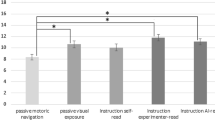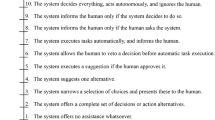Abstract
This article provides a summary of the basic knowledge of human wayfinding found in the literature. It explores the historical roots of the theories (competence literature) and some of the more inductive empirical results (performance literature) of wayfinding. It will point out the limited scope of these investigations compared to the richness of actual human wayfinding, especially in describing the information needs for wayfinding. To address this lack of knowledge the use of the“sense-making” investigation method is suggested. The method is described and several empirical studies are proposed.
Access this chapter
Tax calculation will be finalised at checkout
Purchases are for personal use only
Preview
Unable to display preview. Download preview PDF.
Similar content being viewed by others
References
Anthony, K. H. (1983) ‘Major Themes in the Work of Donald Appleyard’, Environment and Behavior 15(4), 411–418.
Appleyard, D. (1981) Livable Streets, The MIT Press, Cambridge, MA.
Appleyard, D. (1970) ‘Styles and Methods of Structuring a City’, Environment and Behavior 2, 100–117.
Appleyard, D., Lynch, K. and Myer, J. R. (1963) The View from the Road, The MIT Press, Cambridge, MA.
Attneave, F. (1983) ‘Concerning Cognitive Maps: Discussion of Baird and Kuipers’, In Pick, H.L. and Acredolo, L.P. (Eds.), Spatial Orientation: Research, Theory, and Application, Plenum Press, New York, 361–365.
Baird, J. C. and Wagner, M. (1983) ‘Modelling the Creation of Cognitive Maps’, In Pick, H.L. and Acredolo, L.P. (Eds.), Spatial Orientation: Research, Theory, and Application, Plenum Press, New York, 321–344.
Belkin, N. J. Oddy, R. N. and Brooks, H. M. (1982) ‘ASK for Information Retrieval: Part I: Background and Theory’, Journal of Documentation 38(2), 61–71.
Dervin, B. (1983) ‘An Overview of Sense-Making Research: Concepts, Methods, and Results to Date’,Paper presented at the annual meeting of the International Communication Association, Dallas, Texas.
Dervin, B., Jacobson, T., and Nilan, M. (1982) ‘When Cancer Strikes: How Cancer Patients Make Sense out of their Health Situations’, Report to the Office of Cancer Communications, National Cancer Institute, Procurement order #263-MD-102094-3.
Dervin, B., Zweizig, D., Banister, M., Gabriel, M., Hall, E., and Kwan, C. (1976) The Development of Strategies for Dealing with the Information Needs of Urban Residents. Phase I: the Citizen Study’, Final Report on Project L0035JA to the Office of Libraries and Learning Resources, U.S. Office of Education, U.S. Department of Health, Education, and Welfare, (ERIC.ED136791).
Dervin, B. and Martin, M. (1983) ‘Sense-making profiles of Message Queing on Seattle Times Leisure Time Coverage’, Report to the Seattle Times.
Dervin, B. and Nilan, M. (1986) ‘Information Needs and Uses’, in Williams, Martha (Ed.), Annual Review of Information Science and Technology (ARISTA) 21, Knowledge Industry Publications, 3–33.
Evans, G. W. (1980) ‘Environmental Cognition’, Psychological Bulletin. 88(2), 259–287.
Evans, G. W. and Pezdek (1980) ‘Cognitive Mapping: Knowledge of Real World Distance and Location Information’, Journal of Experimental Psychology: Human Learning and Memory 6, 13–24.
Foley, J. E. and Cohen, A. J. (1984) ‘Working Mental Representations of the Environment’, Environment and Behavior 16(6), 713–729.
Garling, T., Book, A., and Lindberg, E. (1986) ‘Spatial Orientation and Wayfinding in the Designed Environment: A Conceptual Analysis and Some Suggestions for Postoccupancy Evaluation’, Journal of Arch. Plan. Res. 3, 55–64.
Garling, T., Book, A., and Lindberg, E. (1984) ‘Cognitive Mapping of Large-Scale Environments: The Interrelationship of Action Plans, Acquisition, and Orientation’, Environment and Behavior 16(1), 3–34.
Golledge, R.G., Smith, T. R., Pelligrino, J., Doherty, S., and Marshall, S. P. ( 1985) ‘A Conceptual Model and Empirical Analysis of Children’s acquisition of Spatial Knowledge’, Journal of Environmental Psychology 5,125–152.
Golledge, R. G. and Zannaras, G. (1975) ‘Cognitive Approaches to the Analysis of Human Spatial Behavior’, In Ittelson, W. (ed.), Environment and Cognition, Seminar Press, New York.
Hart, R. A. and Moore, G. T. (1973) The Development of Spatial Cognition: A Review’, in Downs, R.R. and Stea, D. (Eds.), Image and Environment --Cognitive Mapping and Spatial Behavior, Aldine, Chicago, 111., 246–288.
Hirtle, S. C. and Jonides, J. (1985) ‘Evidence of Hierarchies in Cognitive Maps’, Memory and Cognition 13,208–217.
Judge, P. C. (1990) ‘Computers to Help Drivers Find Their Way’, New York Times, Apr 24, 1990, D12.
Kovach, R. C, Surrette, M. A. and Aamodt, M. G. (1988) following Informal Street Maps: Effects of Map Design’, Environment and Behavior 20(6), 683–699.
Kuipers, B. (1983) The Cognitive Map: Could It Have Been Any Other Way?’, In Pick, H.L. and Acredolo, L.P. (Eds.), Spatial Orientation: Research, Theory, and Application, Plenum Press, New York, 345–359.
Kuipers, B. (1982) The Map in the Head Metaphor’, Environment and Behavior 14,202–220.
Kuipers, B. (1978) ‘Modeling Spatial Knowledge’, Cognitive Science 2,129–153.
Kuipers, B. (1977) Representing Knowledge of Large-Scale Space, The MIT AI Lab, TR-418, (Doctoral Thesis, MIT Mathematics Dept), Cambridge, MA.
Leiser, D. and Zilbershatz, A. (1989) The Traveller: A Computational Model of Spatial Network Learning’, Environment and Behavior 21(4), 435–463.
Lindberg, E. and Garling, T. (1987) ‘Memory for Spatial Location in Two-Dimensional Arrays’, Acta Psychologica 64,151–166.
Lloyd, R. and Steinke, T. (1986) The Identification of Regional Boundaries on Cognitive Maps’, Professional Geographer 38(2), 149–159.
Lynch, K. (1960) Image of the City, The MIT Press, Cambridge, MA.
Marble, D. F. and Bowlby, S. R. (1968) ‘Shopping Alternatives and Recurrent Travel Patterns’, in Horton, F. (ed.), Geographic Studies of Urban Transportation and Network Analysis, Northwestern Univ.Studies in Geography 16, Northwestern Univ. Press, Evanston, III.
Mark, D. M. (1990) The House on the Lake: Toward a Cross-Linguistic Computational Model of Geographic Relations’, Draft manuscript, NCGIA, SUNY Buffalo, Dept of Geography.
Mark, D. M. and Frank, A. U. (1989) ‘Concepts of Space and Spatial Language’, Proceedings, International Symposium on Computer-Assisted Cartography (Auto-Carto 9), Baltimore, MD., 538–556.
Mark, D. M. and McGranaghan, M. (1986) ‘Effective Provision of Navigational Assistance to Drivers: A Cognitive Science Approach’, in Blakemore, Michael (ed.), Proceedings, Auto Carto: International Conference on the Acquisition, Management, and Presentation of Spatial Data, London, International Cartographic Association (ISBN: 0854063129).
Mark, D. M., Svorou, S., and Zubin, D. (1988) ‘Spatial Terms and Spatial Concepts: Geographic, Cognitive, and Linguistic Perspectives’, Proceedings, International Geographic Information Systems (IGIS) Symposium: The Research Agenda 2: Technical Issues and the Research Agenda, NASA, Arlington, Virginia, 101–112.
Marr, D. (1982) Vision: A Computational Investigation into the Human Representation and Processing of Visual Information, W. H. Freeman, San Francisco.
McCalla, G. I. and Schneider, P. F. (1979) The Execution of Plans in an Independent Dynamic Microworld’, Proceedings, Sixth International Joint Conference of Artificial Intelligence, Tokyo, Japan.
McCalla, G. I. and Schneider, P. F. (1980) Planning in a Dynamic Microworld’, in Proceedings, Third Biennial Conference of the Canadian Society for the Computational Studies of Intelligence, Victoria, British Columbia, 248–255.
McCalla, G. I., Reid, L. and Schneider, P. F. (1982) ‘Plan Creation, Plan Execution, and Knowledge Acquisition in a Dynamic Microworld’, International Journal of Man-Machine Studies 16,89–112.
McGranaghan, M., Mark D. M., and Gould, M. D. (1987) ‘Automated Provision of Navigational Assistance to Drivers’, American Cartographer 14(2), 121–138.
McNamara, T. P. (1984) ‘Mental Representations of Knowledge Acquired From Maps’, Journal of Experimental Psychology, Learning Memory and Cognition 10,723–732.
McNamara, T. P., (1986) The Mental Representations of Spatial Relations’, Cognitive Psychology 18, 87–121.
Moar, I and Carlton, I. R. (1982) ‘Memory for Routes’, Quarterly Journal of Experimental Psychology 34a, 381–394.
Nasar, Jack L., Valencia, H., Omar, Z., Chueh, S., Hwang, J. (1985) ‘Out of Sight Further From Mind: Destination Visibility and Distance Perception’, Environment and Behavior 17(5), 627– 639.
Nilan, M. S., Newby, G. B., Paik, W., and Lopatin, K. (1989) ‘User-oriented Interfaces for Computer Systems: A User-defined Online Help System for Desktop Publishing’, Proceedings, American Association for Information Science.
Pailhous, J. (1970) La Representation de l’Espace Urbain -L’exemple du Chauffeur de Taxi, Paris: Presses Universitaires de France.
Piaget, J. and Inhelder, B. (1967) The Child’s Conception of Space, (orig in French, 1948), Norton, New York.
Passini, R. and Proulx, G. (1988) ‘Wayfinding Without Vision: An Experiment with Congenitally Totally Blind People’, Environment and Behavior 20(2), 227–252.
Riesbeck, C. (1980) ‘“You Can’t Miss It!”: Judging Clarity of Directions’, Cognitive Science 4, 285–303.
Russell, J. A. and Ward, L. M. (1982) ‘Environmental Psychology’, Annual Review of Psychology 32, 651–688.
Sadalla, E. K. and Montello, D. R. (1989) ‘Remembering Changes in Direction’, Environment and Behavior 21(3), 346–363.
Siasa, J. and Garling, T. (1987) ‘Sequential Spatial Choices in the Large-Scale Environment’, Environment and Behavior 19(5), 614–635.
Siasa, J., Svensson-Garling, A., Garling, T., and Lindberg, E. (1986) ‘Interurban Cognitive Distance: The Relationship between Judgements of Straight-line Distances, Travel Distances, and Travel Time’, Geographical Analysis 18,167–174.
Siegel, A. W. and White, S. H. (1975) ‘The Development of Spatial Representations of Large-Scale Environments’, in Reese, H.W. (ed.), Advance in Child Development and Behavior 10, Academic Press, New York.
Simutis, Z. M. and Barsam, H. F. (1983) Terrain Visualization and Map Reading’, In Pick, H.L. and Acredolo, L.P. (Eds.), Spatial Orientation: Research, Theory, and Application, Plenum Press, New York, 161–193.
Stea, D. and Downs, R. M. (1970) ‘From the Outside Looking In At the Inside Looking Out’, Environment and Behavior 2, 3–12.
Streeter, L. A. and Vitello, D. ( 1986) ‘A Profile of Drivers’ Map-Reading Abilities’, Human Factors 28(2), 223–239.
Streeter, L. A., Vitello, D. and Wonsiewicz, S. A. (1985) ‘How to Tell People Where to Go: Comparing Navigational Aids’, International Journal of Man-Machine Studies 22,549–562.
Talmy, L. (1983) ‘How Language Structures Space’, In Pick, H.L. and Acredolo, L.P. (Eds.), Spatial Orientation: Research, Theory, and Application, Plenum Press, New York.
Thorndyke, P. (1980) ‘Performance Models for Spatial and Locational Cognition’, Technical Report R-2676-ONR. Rand Corp., Santa Monica, CA.
Thorndyke, P. M. and Goldin, S. E. (1983) ‘Spatial Learning and Reasoning Skills’, In Pick, H.L. and Acredolo, L.P. (Eds.), Spatial Orientation: Research, Theory, and Application, Plenum Press, New York, 195–217.
Thorndyke, P. and Hayes-Roth, B. (1982) ‘Differences in Spatial Knowledge acquired from Maps and Navigation’, Cognitive Psychology 14,560–589
Trowbridge, C. C. (1913) ‘On Fundamental Methods of Orientation and Imaginary maps’, Science 38, 888–897.
Vanetti, E. J. and Allen, G. L. (1988) ‘Communicating Environmental Knowledge: The Spatial Impact of Verbal and Spatial Abilities on the Production and Comprehension of Route Directions’, Environment and Behavior 20(6), 667–682.
Wickens, C. D. (1984) Engineering Psychology and Human Performance, Merrill, Columbus, Ohio.
Author information
Authors and Affiliations
Editor information
Editors and Affiliations
Rights and permissions
Copyright information
© 1991 Springer Science+Business Media Dordrecht
About this chapter
Cite this chapter
Gluck, M. (1991). Making Sense of Human Wayfinding: Review of Cognitive and Linguistic Knowledge for Personal Navigation with a New Research Direction. In: Mark, D.M., Frank, A.U. (eds) Cognitive and Linguistic Aspects of Geographic Space. NATO ASI Series, vol 63. Springer, Dordrecht. https://doi.org/10.1007/978-94-011-2606-9_9
Download citation
DOI: https://doi.org/10.1007/978-94-011-2606-9_9
Publisher Name: Springer, Dordrecht
Print ISBN: 978-94-010-5151-4
Online ISBN: 978-94-011-2606-9
eBook Packages: Springer Book Archive




